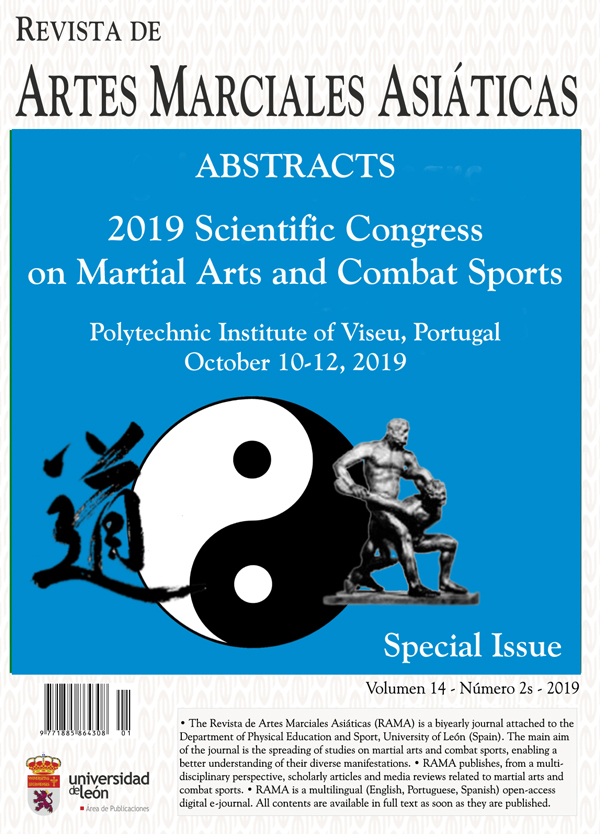Activity profile between winners and losers among female exponents in international silat olahraga competition
DOI:
https://doi.org/10.18002/rama.v14i2s.5944Palavras-chave:
Martial arts, combat sports, silat, silat olahraga, performance analysis, competitionResumo
Aim: The purpose of this study was to determine the details of activity that occurred during the match time between winners and losers among female exponents on Southeast Asian (SEA) Games 2017 silat olahraga competition. Methodology: Twenty female exponents from ten matches (n = 10) of silat olahraga on SEA Games 2017 were selected in this study. The notational analysis focused on fourteen different types of motion categories in silat olahraga: kick, punch, sweep, topple, block, catch, evade/dodge, block and kick, block and punch, block and sweep, fake kick, fake punch, self-release and others. The motion categories were divided into three outcomes, which were Hit Target (HT), Hit Elsewhere (HE) and Missing Opponent (MO). Matched paired t-tests were used to compare differences between winners and losers. Results: There were no significant differences in the activity profiles between winners and losers except for evade/dodge (p = 0.03), but there were significant differences in action outcomes in HT (p = 0.000) and MO (p = 0.025). This study showed that during the match the 51% of the actions were kicks, punches and sweeps. The results also showed that female exponents frequently used lower limbs to attack the opponents. Conclusion: The losers performed less HT actions and higher MO actions compared to the winners. The winners performed more successful actions than the losers during silat matches.
Downloads
Métricas alternativas
Referências
Anuar, A. (1993). Silat olahraga. The art, technique and regulations (2nd edn.). Kuala Lumpur: Dewan Bahasa dan Pustaka.
Anuar, A. W. (2008). Silat Sejarah perkembangan kurikulum silat Melayu tradisi dan pembentukan kurikulum Silat Malaysia moden. Selangor, Malaysia: Hizi Print Sdn Bhd.
Aziz, A. R., Tan, B., & Teh, K. C. (2002). Physiological responses during matches and profile of elite pencak silat exponents. Journal of sports science & medicine, 1(4), 147-155.
Hughes, M. D., & Bartlett, R. M. (2002). The use of performance indicators in performance analysis. Journal of Sports Sciences, 20(10), 739-754. doi: http://doi.org/10.1080/026404102320675602
Hughes, M., & Franks, I. M. (2004). Notational analysis of sport: Systems for better coaching and performance in sport. London: Routledge.
James, N. (2006). The role of notational analysis in soccer coaching. International Journal of Sports Science & Coaching, 1(2), 185-198. doi: http://doi.org/10.1260/174795406777641294
Mackenzie, R., & Cushion, C. (2013). Performance analysis in football: A critical review and implications for future research. Journal of sports sciences, 31(6), 639-676. doi: http://doi.org/10.1080/02640414.2012.746720
O'Donoghue, P. (2015). An introduction to performance analysis of sport. London: Routledge.
O'Donoghue, P. (2010). Research methods for sports performance analysis. London: Routledge.
O'Donoghue, P., & Ingram, B. (2001). A notational analysis of elite tennis strategy. Journal of sports sciences, 19(2), 107-115. doi: http://doi.org/10.1080/026404101300036299
Shapie, M. N. M., Ali Janah, N. A., Kusrin, J., Tumijan, W., & Elias, M. S. (2018). Activity profile between winners and losers in international silat olahraga matches. Journal of Physical Fitness, Medicine & Treatments in Sports, 2(4), 1-4. doi: http://dx.doi.org/10.19080/JPFMTS.2018.02.555592
Shapie, M. N. M., & Elias, M. S. (2015). Silat Olahraga: The malay combat sports. Proceedings of the 1st world congress on health and martial arts in interdisciplinary approach hma, 2015. Czestochowa, Poland Achives of Budo Conference Proceedings.
Shapie, M. N. M., Oliver, J., O'donoghue, P., & Tong, R. (2013). Activity profile during action time in national silat competition. Journal of Combat Sports and Martial Arts, 4(1), 75-79. doi: http://doi.org/10.5604/20815735.1073630
Shapie, M. N., Oliver, J., O’donoghue, P., & Tong, R. (2008). Distribution of fight and break time in international silat competition. In A. Hokelmann & M. Brummond (Eds.), Performance Analysis of Sport VIII (pp. 667-672). Margeburg, Germany: Otto Von Guericke Universitat.
Shapie, M. N. M. (2011). Influence of age and maturation on fitness development, trainability and competitive performance in youth silat (Doctoral Dissertation). Cardiff Metropolitan University, Cardiff, UK. Retrieved from http://hdl.handle.net/10369/4068
Sofwan, N., Norasrudin, S., Redzuan, P., & Mubin, A. (2012). Distinguishing playing pattern between winning and losing field hockey team in delhi fih road to london 2012 tournament. World Academy of Science, Engineering and Technology, International Journal of Social, Behavioral, Educational, Economic, Business and Industrial Engineering, 6(10), 2532-2535.
Teodorescu, S., & Urzeală, C. (2013). Management tools in sports performance. Procedia-Social and Behavioral Sciences, 81, 84-88. doi: https://doi.org/10.1016/j.sbspro.2013.06.392
Downloads
Publicado
Como Citar
Edição
Secção
Licença
Direitos de Autor (c) 2019 J An Pawista

Este trabalho encontra-se publicado com a Licença Internacional Creative Commons Atribuição-NãoComercial-CompartilhaIgual 4.0.
Os autores que publicam nesta Revista estão de acordo com os seguintes termos:
- Os autores cedem, de forma exclusiva, os direitos de exploração (reprodução, distribuição, comunicação pública, transformação) à Universidade de Léon, podendo estabelecer, em separado, acordos adicionais para a distribuição não exclusiva da versão do artigo publicado na Revista (por exemplo: alojar no repertório institucional ou publicá-lo num livro), com o reconhecimento da publicação inicial nesta Revista.
- O trabalho encontra-se na Creative Commons Attribution-Non Commercial-Share Alike 4.0 International License. Pode-se consultar aqui o resumo e o texto legal da licença.
- Permite-se, e sugere-se, que os autores difundam electronicamente as versões pré-impressão (versão antes de ser avaliada) e pós-impressão (versão avaliada e aceite para publicação das suas obras antes da sua publicação), favorecendo a sua circulação e difusão, e com ela o possível aumento da sua citação e alcance pela comunidade académica.











